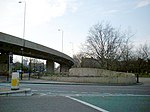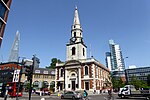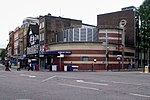Southwark

Southwark ( (listen) SUDH-ərk) is a district of Central London situated on the south bank of the River Thames, forming the north-western part of the wider modern London Borough of Southwark. The district, which is the oldest part of South London, developed due to its position at the southern end of the early versions of London Bridge, the only crossing point for many miles. London’s historic core, the City of London, lay north of the Bridge and for centuries the area of Southwark just south of the bridge was governed by the City. By the 12th century Southwark had been incorporated as an ancient borough, and this historic status is reflected in the alternative name of the area, as Borough. The ancient borough of Southwark's river frontage extended from the modern borough boundary, just to the west of by the Oxo Tower, to St Saviour's Dock (originally the mouth of the River Neckinger) in the east. The urban area expanded over the years and Southwark was separated from the City in 1900. Local points of interest include Southwark Cathedral, Borough Market, Shakespeare's Globe theatre, The Shard, Tower Bridge, Butler's Wharf and the City Hall offices of the Greater London Authority from 2002 to 2021.
Excerpt from the Wikipedia article Southwark (License: CC BY-SA 3.0, Authors, Images).Southwark
Tabard Street, London Borough (London Borough of Southwark)
Geographical coordinates (GPS) Address Nearby Places Show on map
Geographical coordinates (GPS)
| Latitude | Longitude |
|---|---|
| N 51.4988 ° | E -0.0901 ° |
Address
Becket House
Tabard Street
SE1 4XZ London, Borough (London Borough of Southwark)
England, United Kingdom
Open on Google Maps










